Running With Your Dog
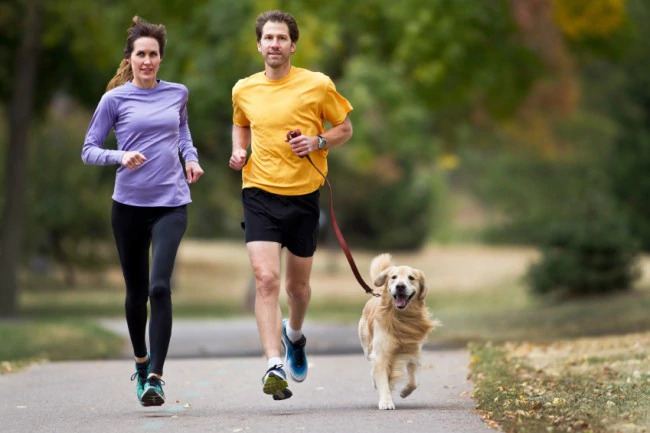
11 Tips to Help You to Enjoy Running with Your Dog
Running with your dog is a fun way to spend time together and will help to keep both of you fit and healthy. Dogs are always eager to get out and about and always have plenty of excess energy. And, admit it, it’s so much more difficult to skip your run when your dog knows it’s that time of day and is standing at the door with their lead in their mouth.
How to enjoy running with your dog
Before you start running with your dog you will need to do some training so that the run is enjoyable for both of you. Not all dogs are suited to run multiple kilometres but many of them can learn to be great running partners.
Your dog should be trained at loose-lead walking before you start training her to run beside you. A canine that continues to pull on the lead when walking can actually be dangerous when running.
It is essential to keep your dog on your left when you start running together. If he runs in front of you or weaves from side-to-side he can trip you or tangle your legs in the lead.
It’s also important for your dog to learn the “Leave It” command. You need to do this so that she will ignore tempting items like food, roadkill or sticks. Teaching her “Sit” and “Stay” is also helpful, especially when crossing roads.
Which breeds are best for running?
Some of the breeds that are known to be better long-distance (more than 10 kms) running buddies are German Short-haired Pointers, Border Collies, Kelpies, Huskies and Jack Russells. Dogs more suited to middle-distance (less than 10 kms) runs are Labradors, Golden Retrievers and Greyhounds. Other good breeds to run with include Vizslas, German Shepherds and Dalmatians. Very large dogs e.g. Mastiffs and Great Danes are typically not suited to running.
Are there any breeds that shouldn’t run?
Brachycephalic (short-nosed dogs) such as Pugs, Bulldogs, Boston Terriers, Pekingese, Shih Tzus have narrowed nostrils and partially obstructed airways which makes it very difficult for them to be able to withstand running. These breeds overheat faster than other breeds and can’t inhale enough oxygen to be able to do strenuous exercise.
Can I run with my puppy?
It is important to be aware that running is not safe for puppies. Pups’ bones are still growing so it is best to wait until your pup is about one and a half years old.
The age that a pup can start running with you varies by breed and size of dog. Smaller dogs, like Jack Russells, could start going on runs earlier than larger dogs, like Great Danes.
If unsure, check with your vet
If you’re just not sure if your dog is suited to running do some research about the breed or check with your veterinarian.
How to start running with your dog
Start slowly! It is recommended that we build up gradually and the same is recommended for your dog. Here are some tips on the best way to start running with your dog:
- Start by taking long walks each day. Commence with 2kms if possible. This will help to build your dog’s fitness (and possibly yours too!).
- Gradually replace a couple of walks a week with slow jogging. You may need to jog part of the way and walk the rest. It’s important to watch your dog to make sure she is coping with going faster. If you notice excessive fatigue or a reluctance to continue this could be a sign that you need to take it more slowly.
- Replace more walks with runs each week until you are running each time.
- Then you can start to gradually increase the distance and the speed.
- Your dog will need time for her muscles and joints to recover so it is best not to run every day of the week.
What to take on the run
There are a few essentials you need to take with you when running with your dog:
Lead
In most areas it is essential to keep your dog on a lead at all times.
Don’t use a retractable lead. These leads aren’t suitable for running as they can easily tangle. A check chain is unsuitable for running as it can collapse your dog’s trachea which can be dangerous if your dog is already short of breath and panting excessively.
The best lead to use is a relatively short one of 1 to 2 metres. It is also important to use a soft lead that doesn’t cut into your hand if your dog pulls. We prefer round leads which are softer on your hand and easier to grip but, unfortunately, they are very difficult to find these days.
This Rogz lead uses reflective stitching and is made with after dark visibility in mind. It is ideal for those who take their dog out after work or first thing in the morning and comes in four sizes.
This Black Dog lead is a quality lead for everyday use, with the added advantage of being length adjustable.
Harness
You should use the dog harness that best suits you and your dog. Harnesses control lead pulling no matter what size your dog is. They effectively prevent him from yanking the lead and from putting pressure on his neck and trachea.
We love the Ezydog Drive harness as you can use it as both a travel and walking harness. It keeps your dog safe and secure during the drive and hooks up to a lead the moment it’s time to get out and run (or walk). The stainless steel D rings at the top of the harness allow for a swift change from lead to seatbelt in seconds.
Head Halter
Sometimes a regular collar or harness isn’t enough for some dogs which is when this Sporn head halter may work better.
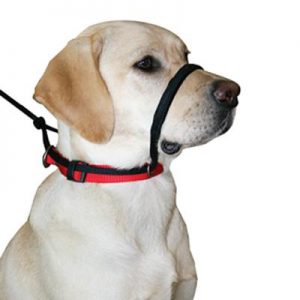 A head halter consists of a strap that goes around your dog’s nose and another strap that goes around his neck, just behind his ears. You then attach the lead to the halter under your dog’s chin to a ring that’s also attached to the nose strap. When your dog begins to pull, the head halter causes the dog’s nose to be turned down and back toward you. This makes it physically difficult for him to continue pulling.
A head halter consists of a strap that goes around your dog’s nose and another strap that goes around his neck, just behind his ears. You then attach the lead to the halter under your dog’s chin to a ring that’s also attached to the nose strap. When your dog begins to pull, the head halter causes the dog’s nose to be turned down and back toward you. This makes it physically difficult for him to continue pulling.
The head halter is a gentle alternative to choke chains and prong collars as it teaches your dog not to lunge. If your dog lunges, stop walking and he will be forced to turn around and away from the object at which he was lunging.
Stay visible when running with your dog
The Rogz Safety Light for dog collars and leads will increase the visibility, of both you and your dog, to traffic.
It can be attached to your dog’s collar, lead or harness. This light can be set to flicker or constant and comes in blue, red or “glow”.
Keep your dog hydrated
Keep your dog hydrated throughout the run. One way to do this is to take a foldable water bowl with you that will tuck into a pouch or you might be able to plan your run where you know your dog will have access to clean water.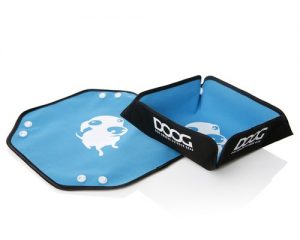
Safely running with your dog
Here are some tips to ensure that your dog is safe and enjoys running with you and you with him:
- Warm your dog up before the run and let him cool down by walking for several minutes at the end.
- Check the temperature before heading out. Dogs can’t handle heat and humidity as well as we can. In summer it is best to run early in the morning or late in the day when it has cooled down.
- Run on soft surfaces wherever possible. Avoid concrete, hot bitumen and watch out for sharp objects e.g. broken glass that can harm the paws. If you are running off-road your dog may benefit from doggy boots. Make sure you choose the right size for your dog.
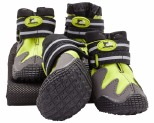
- When running for more than 30 minutes carry water with you and maybe even a collapsible water bowl or take a route that has water available for your dog.
- Allow your dog to have some breaks so that he can recharge, have a pee and a bit of a sniff.
- Watch your dog for signs that he’s overheating. These include excessive panting, foaming at the mouth, glazed eyes or running more slowly. Some dogs will continue to run just to please their owner, even when they have had enough. These signs can indicate heatstroke. Immediate treatment is to find shade and give him a small amount or cool or air temperature water. If there is water nearby pour it over him or let him wade in it if it is safe to do so. If in doubt contact your vet
- Use a 4- to 6-metre lead as longer leads can cause problems if your dog isn’t close enough to you when running.
Plan for pooping
Remember to take poop bags with you when head out for a run. It’s also a good idea to know where along the way you can dispose of the bag. If you are concerned about adding more plastic to our environment you can buy eco-friendly poop bags which are biodegradable.
Tick protection
Running through bushland near to Australia’s east coast may put your dog at risk of picking up ticks along the way. Make sure your dog is up-to-date on tick medication and check for ticks that may have hitched a ride home. See our article on Watch Out For Ticks for vital information on tick prevention. It also describes how to check for ticks and what to do if you find a tick on your dog.
After running with your dog
Remember to check your dog’s paws to make sure they don’t have any cuts. On hot days it is also possible that their pads can suffer burns.
After your run (and during), watch your dog for signs of heatstroke. These signs include drooling, frothing at the mouth, excessive panting, weakness, dark red gums, vomiting and bloody diarrhea.
Don’t allow your dog drink too much water during or after exercise. If a dog is really hot and thirsty they may drink too much all at once. This can cause potentially fatal water toxicity or bloat, a dangerous condition in which they ingest large amounts of air.
Please share your feedback or tips
We hope you enjoy going for runs with your dog and would love you to leave comments below to tell us what you learnt from our blog about running with your dog. If you are already enjoying this activity we’d love you to share any tips or humorous stories. Scroll down to leave comments.
See also Get Fit With Your Dog for more ideas on activities for you and your dog.
Or, have a look at 10 workouts you can do with your dog if running is not your thing.
Disclosure: Some links in this blog are affiliate links. You don’t pay more for the product but, if you buy from the link, we’ll get a commission. We only recommend products and online retailers we trust.
Recommended Posts
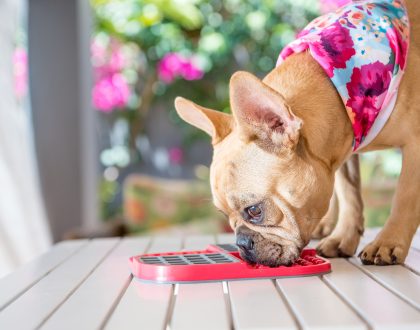
Lickimat – 20% OFF
February 27, 2024
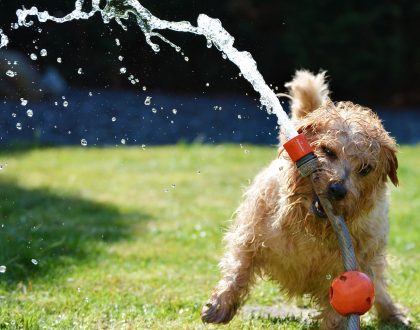
Hot weather and your dog
January 05, 2024

Frozen Kong recipes
January 05, 2024
Comments
Leave a Reply
You must be logged in to post a comment.

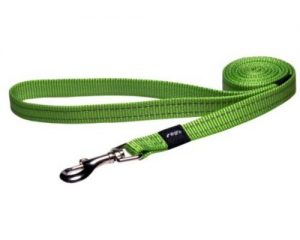
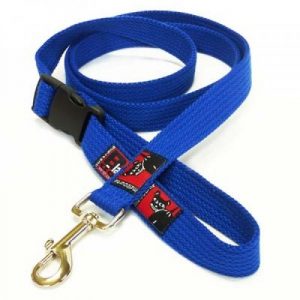
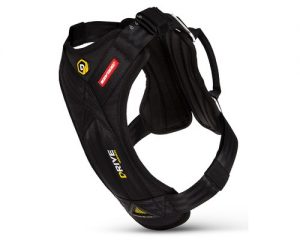

Thanks for this article – very helpful. When you say you prefer a round lead do you mean the actual shape of the lead fabric is round like rope? I have bought these previously in the local $2 shop and they are about 2 metres long and have lasted quite a while.
Hi Cathy
Yes, they are the ones I prefer. I bought a couple years ago and they have lasted for such a long time. I prefer the ones that are 1 metre as they give you more control.
I love to go running with my beagle and he loves it too – when he sees me in my running shoes he literally jumps for joy. Living in Australia, we are night runners as it’s a lot cooler but I always worry about visibility. The Rogz Safety Light is definitely something I will be investing in – thanks for the tips!
Great to hear about your Beagle’s excitement for running, Charlie. Thanks for telling us about that. It will be good to hear about what you think of the safety light once you start using that.